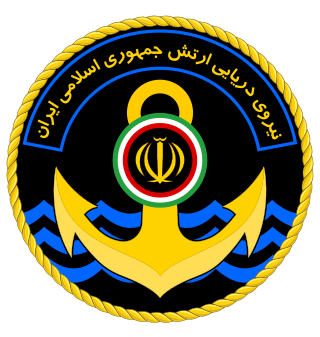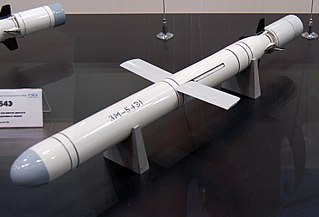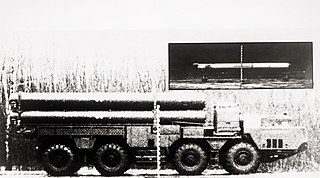
A cruise missile is an unmanned self-propelled guided vehicle that sustains flight through aerodynamic lift for most of its flight path and whose primary mission is to place an ordnance or special payload on a target. Cruise missiles are designed to deliver a large warhead over long distances with high precision. Modern cruise missiles are capable of traveling at high subsonic, supersonic, or hypersonic speeds, are self-navigating, and are able to fly on a non-ballistic, extremely low-altitude trajectory.

The TomahawkLand Attack Missile (TLAM) is a long-range, all-weather, jet-powered, subsonic cruise missile that is primarily used by the United States Navy and Royal Navy in ship and submarine-based land-attack operations.

A cruise missile submarine is a submarine that carries and launches cruise missiles as its primary armament. Missiles greatly enhance a warship's ability to attack surface combatants and strike land targets; although torpedoes are a more discrete option for submerged submarines, missiles give a much longer stand-off range, shorter time to impact the target, as well as the ability to engage multiple targets on different headings at the same time. Many cruise missile submarines retain the capability to deploy nuclear warheads on their missiles, but they are considered distinct from ballistic missile submarines due to the substantial differences between the two weapons systems' flight characteristics; cruise missiles fly aerodynamically using flight surfaces like wings or fins, while a ballistic missile uses its engine power alone as it may exit the atmosphere.

A submarine-launched cruise missile (SLCM) is a cruise missile that is launched from a submarine. Current versions are typically standoff weapons known as land-attack cruise missiles (LACMs), which are used to attack predetermined land targets with conventional or nuclear payloads. Anti-ship cruise missiles (ASCMs) are also used, and some submarine-launched cruise missiles have variants for both functions.

The Islamic Republic of Iran Navy or Iranian Navy, officially abbreviated NEDAJA, is the naval warfare service branch of Iran's regular military, the Islamic Republic of Iran Army (Artesh). It is one of Iran's two maritime military branches, alongside the Navy of the Islamic Revolutionary Guard Corps (IRGC).

The Popeye is a family of air-to-surface missiles developed and in use by Israel, of which several types have been developed for Israeli and export users. A long-range submarine-launched cruise missile variant of the Popeye Turbo has been speculated as being employed in Israel's submarine-based nuclear forces. The United States operated the Popeye under a different designation according to US naming conventions as the AGM-142 Have Nap.

The Novator Kalibr, also referred to as 3M54-1 Kalibr, 3M14 Biryuza, is a family of Russian cruise missiles developed by NPO Novator (OKB-8). It first saw service in 1994. There are ship-launched, submarine-launched and air-launched versions of the missile, and variants for anti-ship, anti-submarine and land attack use. Some versions have a second propulsion stage that initiates a supersonic sprint in the terminal approach to the target, reducing the time that air defense systems have to react, while subsonic versions have greater range than the supersonic variants. The missile can carry a warhead weighing up to 500 kilograms (1,100 lb) of explosive or a thermonuclear warhead.

Ghadir is a class of midget submarines built by Iran specifically for cruising within the shallow waters of the Persian Gulf. The Islamic Republic of Iran Navy is the sole operator of this class, whose all submarines serve in the Southern Fleet. No submarine of this class is active at the Northern Fleet, i.e. the Caspian Sea.

The Novator RK-55 Relief is a Russian Navy cruise missile that is launched either from submarines (SLCM) or from surface ships. It can have a nuclear warhead developed in the Soviet Union. A version launched from submarine torpedo tubes, the S-10 Granat, has apparently been converted to carry conventional warheads and continues in service to this day. The Russian Federation was reported to have deployed the derivative SS-CX-7/SS-CX-8 systems on 14 February 2017. The land launched version is called the Novator 9M729.

The Harpoon is an all-weather, over-the-horizon, anti-ship missile manufactured by McDonnell Douglas. The AGM-84E Standoff Land Attack Missile (SLAM) and later AGM-84H/K SLAM-ER are cruise missile variants.

The Nasr-1 is an Iranian anti-ship cruise missile. According to its export catalog, it can destroy 1,500-tonne targets such as small frigates. Nasr-1 missile can be launched from both inland bases and offshore military vessels, and is being modified to be fired from helicopters and submarines.

The HESA Karrar is an Iranian jet-powered target drone manufactured by Iran Aircraft Manufacturing Industrial Company (HESA) since 2010. The Karrar is a derivative of the American 1970s-era Beechcraft MQM-107 Streaker target drone, probably incorporating elements from the South African Skua, with hardpoints added for munitions. The Karrar was developed during the Ahmadinejad presidency.

Fateh is an Iranian designed class of semi-heavy submarines. The Iranian media reported that Fateh class subs can operate more than 200 meters (660 ft) below the sea surface for nearly five weeks.

Jamaran is the lead ship of the Iranian Moudge-class frigate launched in early 2010 in Bandar-e-Abbas, Iran. Iran has stated that the design and building of Jamaran was among the greatest achievements of the Iranian Navy and the ship's launch marks a major technological leap for Iran's naval industries. More ships in its class are under construction to be added to the Iranian fleets in the Caspian Sea and the Persian Gulf. The ship is designed for a crew of 140. Jamaran combines anti-submarine assets with other systems of weapons capable of dealing with surface and air threats as well.
IRIS Taregh or Tareq is the first Kilo-class attack submarine of Islamic Republic of Iran Navy, serving in the Southern Fleet. The submarine is part of the 33rd Flotilla, along with two other vessels.

Fateh is a coastal submarine of the Islamic Republic of Iran Navy, and the lead ship of her class. She was commissioned into the Southern Fleet on 17 February 2019 at Bostanu shipyard, Bandar Abbass, and bestowed by Iranian President Hassan Rouhani.

Abu Mahdi, complete name: "Shahid (Martyr) Abu-Mahdi al-Muhandis missile", is an Iranian naval cruise missile with a range of over 1000 km. The missile is named after Abu Mahdi al-Muhandis, an Iraqi companion of Qasem Soleimani who was killed in an American airstrike in 2020. It was unveiled on 20 August 2020 simultaneously with the Haj-Qasem missile. The Abu Mahdi missile can be launched by diverse types of platforms, including sea, land and air launchers.

Joint Exercise Zolfaghar 99 was a large-scale military exercise conducted jointly by all four branches of the Islamic Republic of Iran Army between 10 and 12 September 2020. The drills were held at the Sea of Oman and the Indian Ocean 10 degrees north of the Equator, including about 2 million-square-kilometer of area. Held in three phases, it involved intelligence, tactics and show of force.















